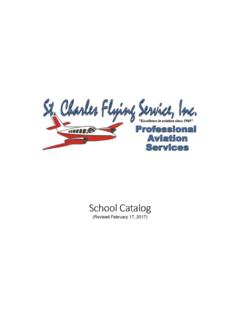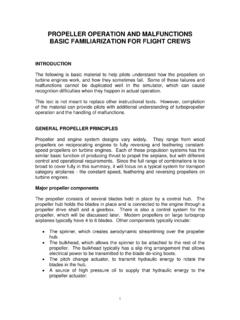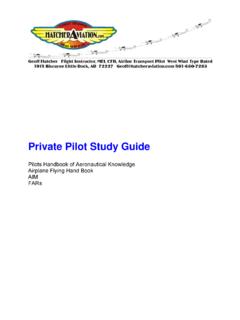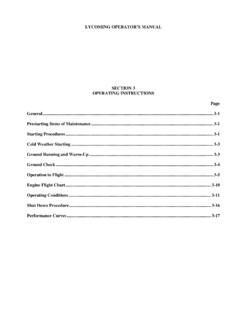Transcription of Multi-Engine Training Packet
1 Multi-Engine Training Packet This Multi-Engine Training course is designed for the Commercial Multi-Engine Rating, MEI and ATP. This Packet , in conjunction with the BE-76 Pilot s Operating Handbook contains all the information you need for the Multi-Engine course. Success in this Training course depends on your study preparation and your instrument flying proficiency. Program Itinerary This study Packet is designed for commercial- multi , ATP, and MEI candidates. The Training schedule is flexible but fairly standard. *Note* The applicant should be instrument current and proficient. Below are Training outlines for each specific rating. The key to success and minimal stress is preparation. With the exception of the actual BE-76 flight manual, this Packet contains everything you need for the Multi-Engine course.
2 Airline Transport Pilot Maneuvers (IR): Steep Turns Slow Flight Approaches to Stalls (3) engine Failure (takeoff, climb, cruise) Normal/Crosswind Takeoff & Landing Recovery from Unusual Attitudes No-Flap Landing Instrument Approaches: All approaches will be at KALN & KSET.* 2 approaches will be precision, 1 with a landing, 1 single engine 2 approaches will be non-precision 1 partial panel, 1 with a procedure turn (or TAA). * Any approach at any airport in the area is an option for the examiner. *Note: most commonly used approaches are: ILS 29 @ ALN VOR-A @ ALN LOC BC 11 @ ALN GPS 18 @ SET VOR 18 @ SET The approaches above will include: Circle-to-land Missed approach and hold Missed approach- single engine Straight-in landing Rejected landing Day 1 Approximately 4 hours of flight Training Ground instruction as required for the rating Day 2 Prep for oral exam Brush-up/ practice checkride flight Checkride Commercial- multi and MEI Maneuvers (VR).
3 Slow Flight Steep Turns Power off/on Stalls Accelerated Stall engine Failure (takeoff, climb, cruise) Vmc Demo- Loss of directional control demonstration Drag Demo (MEI only) Emergency Descent Short Field Takeoff & Landing Normal/Crosswind Takeoff & Landing *Note: MEI applicant does all from the right seat. Instrument Approaches: Mandatory for all applicants that are instrument-rated.
4 Does not apply to MEI candidates *Note: Any approach at any airport in the area is an option for the examiner. Most commonly used approaches: VOR 18 @ SET GPS 18 @ SET Approach & landing will be single- engine . Flying Light Twins (General) The most important phase of Multi-Engine flying is: Preflight Planning Most critical phase of light twin flying is: Takeoff FAR Part 23 puts forth certification requirements for light twins with a max gross weight of less than 12,500 lbs. Certification Requirements: At 5,000 ft. international standard atmosphere the airplane performance must be determined by the manufacturer for certification.
5 6001 12,500 lbs. Must climb clean at 5,000 ISA Rate of climb (ROC) = (.027 x Vso ) 6,000 lbs. or less If Vso = 61 kts CAS or greater. Must perform a positive ROC (.027 x Vso ) If Vso = less than 61 kts Does not have to do anything. Can be a negative ROC. Examples: C-310 5,300 lbs. Vso = kts. x .027 = fpm ROC Reality ROC = 119 fpm BE-76 3,900 lbs. Vso = 60 kts. Reality ROC = 50 fpm Climb Performance Climb performance is dependent on the excess power needed to overcome drag. When a twin- engine airplane loses an engine , the airplane loses 50% of its available power. This power loss results in a loss of approximately 80% of the aircraft s excess power and climb performance.
6 Drag is a major factor relative to the amount of excess power available. An increase in drag (such as the loss of one engine ) must be offset by additional power. This additional power is now taken from the excess power, making it unavailable to aid the aircraft in climb. When an engine is lost it is essential to achieve optimum single engine climb performance by: Maximizing thrust- full power Minimizing drag- flaps & gear up, feather prop Drag Factors: 1. Full Flaps- 400 fpm approx. 2. Windmilling Prop- 400 fpm approx. 3. Gear Extended- 150 fpm approx. Single engine Aerodynamics A twin engine aircraft that has both propellers rotating the same direction (usually clockwise as viewed from inside the cockpit) is called a conventional twin. Since the same left-turning tendencies of a single engine airplane affect a Multi-Engine airplane, counter-rotating propellers have been developed to help combat those tendencies.
7 The p-factor and torque from counter-rotating propellers cancel each other out which results in less rudder needed to oppose these tendencies. What happens when an engine fails? When an engine fails, there are two things that will happen: Yaw and Roll. An aircraft with a failed engine will yaw and roll towards the dead engine due to asymmetric lift, thrust, and drag. 1. Asymmetric thrust will cause a yawing moment around the towards the dead engine . 2. Accelerated slipstream (or induced flow) is extra lift created by air accelerated from an operating engine forced over the wing. There is a lack of this induced flow over the wing with the failed engine . This results in a rolling moment around the toward the inoperative engine . To counteract the roll and yaw, you must apply rudder towards the operating engine ! DEAD FOOT, DEAD engine ! Zero Sideslip Just using rudder to maintain direction will put the aircraft into a sideslip, which introduces the fuselage to the relative wind creating a large amount of drag.
8 We need to minimize this drag as much as possible while still maintaining heading. The solution is to improve performance by using a zero sideslip condition. When the aircraft is banked 2 - 5 toward the operating engine , the dihedral of the wing will create a horizontal component of lift. This will minimize the rudder deflection required to align the longitudinal axis of the airplane to the relative wind. With this bank, the appropriate amount of rudder deflection will be indicated on the inclinometer by the ball being halfway deflected toward the operating engine . RAISE THE DEAD! Service Ceiling- This is the maximum density altitude where the best rate of climb airspeed (Vx) will produce a 100 fpm climb with both engines at max continuous power. Absolute Ceiling- This is the maximum density altitude that the airplane is capable of attaining or maintaining at max gross weight in the clean configuration and max continuous power.
9 As altitude increases, Vx increases, while Vy decreases. Where these two speeds converge is absolute ceiling. Single engine Service Ceiling- This is the maximum density altitude at which the aircraft can maintain a 50 fpm climb with one engine operating at full power and one engine with a feathered propeller. This is critically important, especially when flying over mountainous terrain. If the aircraft is above the single engine service ceiling when an engine fails, it will slowly drift down to its single engine service ceiling. This should be determined during flight planning using the single engine service ceiling chart from the POH. Example: Aircraft cruising altitude: 12,000 MEA: 9,500 Single engine service ceiling: 6,000 If the aircraft has an engine failure at 12,000 , it will drift down to 6,000 . If you are IMC this could be very bad. Always plan for an engine to fail!
10 Choose a different route with a lower MEA. Vyse- This is best rate of climb single engine . Vyse is identified by the blue radial on the airspeed indicator. Always pitch for blue line when an engine fails. It will give you the best single engine performance, although it may not be a climb. In the BE-76 Duchess, Vyse is 85 KIAS. Vxse- This is best angle of climb single engine . If you have obstacles to clear with an engine failed, use Vxse. Once the obstacles are cleared, pitch for Vyse. In the BE-76 Duchess, Vxse is also 85 KIAS. Vsse- This is the minimum speed at which an intentional engine cut can be performed. It gives a safety margin from Vmc for safe engine cuts while Training . MEI candidates need to know this. It is 71 KIAS in the Duchess. Action when an engine fails- Memorize this!! 1. POWER UP- right to left: mixtures full, props full, throttles full 2. CLEAN UP- flaps up, gear up, aux fuel pumps on 3. IDENTIFY- Dead foot, Dead engine 4.



